You Don’t Need A Mountain Spring With These Filtered Water Bottles
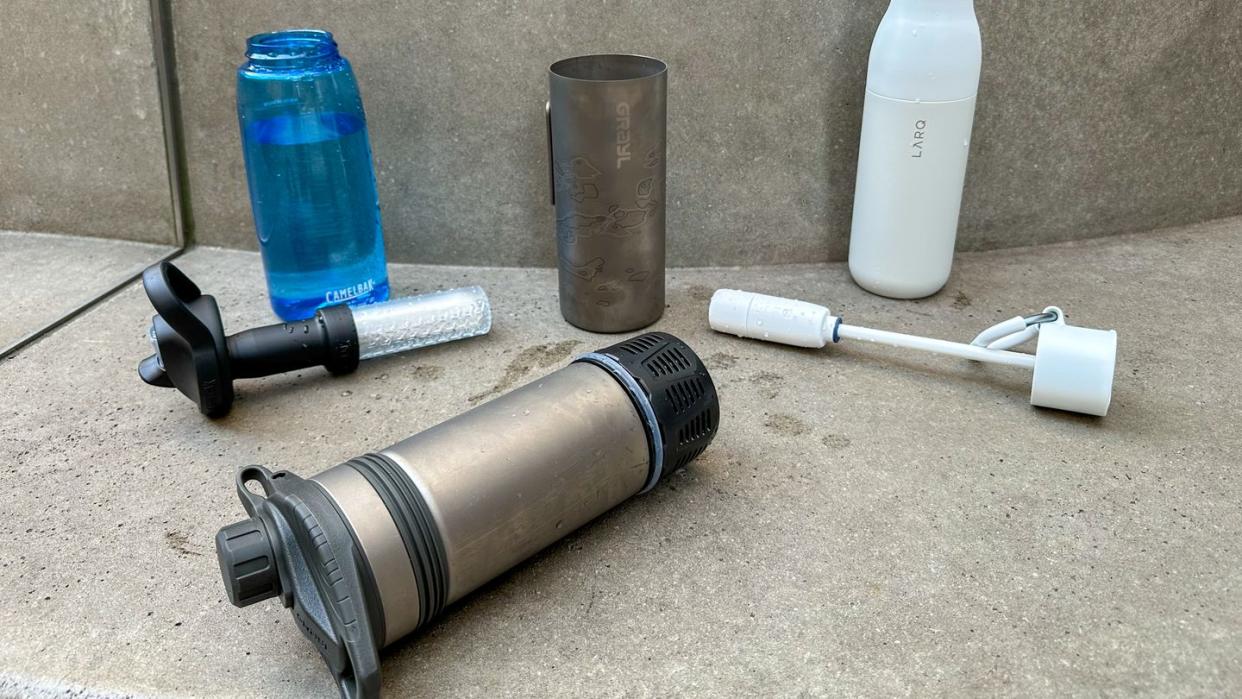
"Hearst Magazines and Yahoo may earn commission or revenue on some items through these links."
A filtered water bottle can give you great tasting, safe water from sources like a questionable trail spigot or your office fountain that no one seems to really clean. Some rely on the same filtration methods as home water filters, while others go a step further to protect you from virus-causing pathogens when camping and hiking. You may not always be able to control your water source, but you can have a filtered water bottle that removes impurities and pollutants that affect the taste and quality of what you’re drinking.
There are a lot of buzz words, dramatic health warnings, and good research surrounding filtered water bottles and water filters in general, but most of us aren’t scientists—myself included. Through speaking with multiple sources and researching what exactly a filtered waster bottle is capable of doing, I was able to determine why they’re a good idea, which work well, and which are worth passing over.
The Best Filtered Water Bottles
Best Overall: Grayl GeoPress
Best Budget Option: Brita Filtered Water Bottle with Straw
Fastest Filter: LifeStraw Peak Series Squeeze Bottle
Most Sleek Design: Larq Bottle Filtered
Best for Backpacking: Katadyn BeFree Bottle
What to Consider
What Do You Want to Filter Out?
The filtered water bottle you choose largely depends on what you want removed from your drinking water and the water source. There are thousands of different particulates in the water we drink and there isn’t one filter that takes out every single unwanted impurity. Travis Merrigan, biochemist and co-founder of Grayl—the company that makes one of the bottles I recommend below—notes the different priorities of different filters.
“The truth is, it’s pretty easy to remove a lot of the materials that make water taste bad. Any $12 filter will remove chlorine to the point where you can’t taste it,” he says.
Those who want to improve the taste or smell of their tap water—also referred to as aesthetic effects—can opt for a basic filtered water bottle that reduces chlorine. The EPA sets forth guidelines for municipal water supply, but the requirements are pretty loose and your water can still contain chlorine, copper, and asbestos. Most filtered water bottles will remove particulates and chlorine for better tasting water, but other contaminants that can be harmful over time will remain.
The Environmental Working Group has stricter guidelines than the EPA. The organization’s Tap Water Database offers detailed information on the quality of your drinking water based on your zip code.
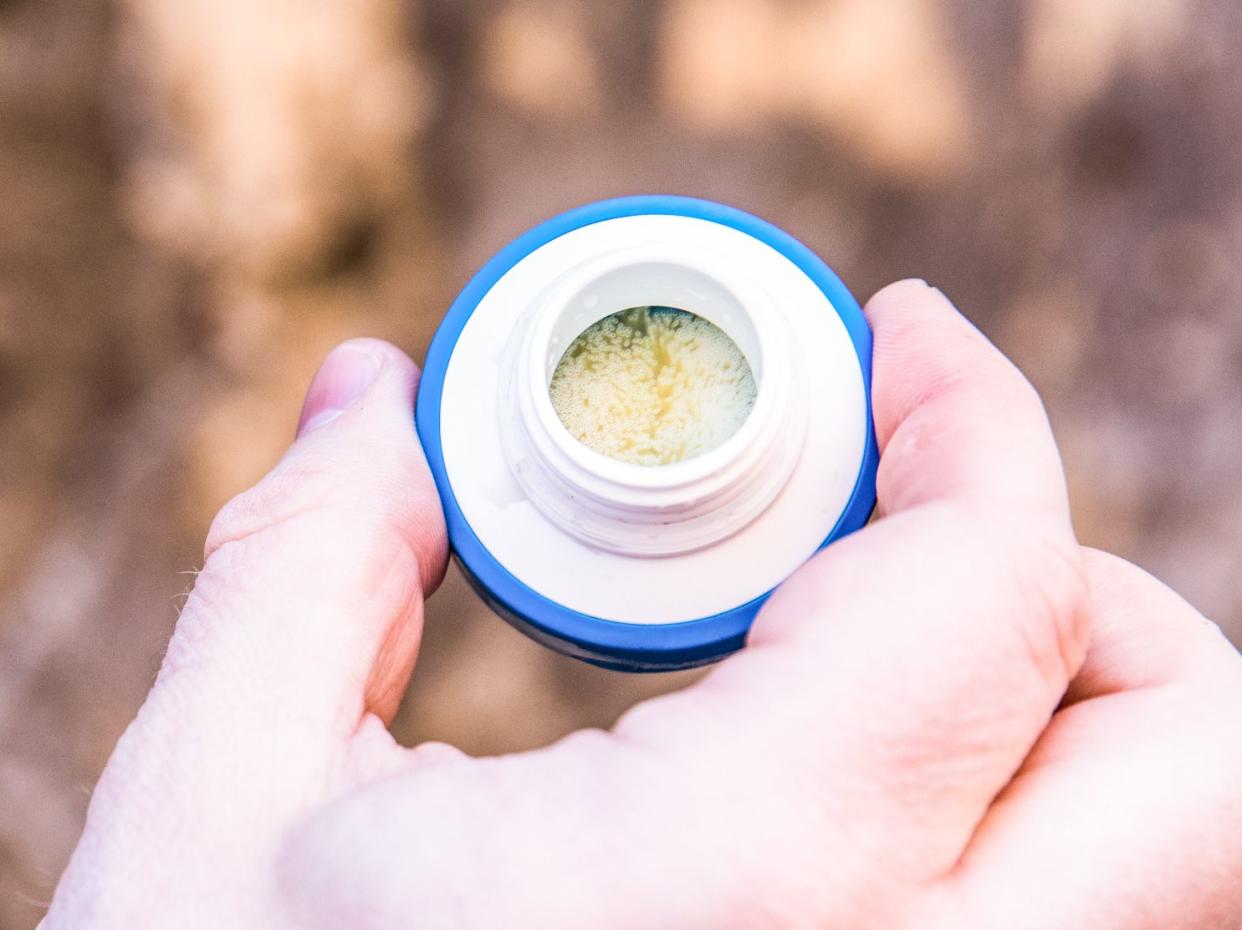
Hollow fiber membrane filters have densely woven fibers that trap organic matter, and some heavy metals. Product listings sometimes note the size of particles that are blocked in microns. For example, our best for backpacking pick and best for tap water choice use a 0.1 micron filter, meaning anything bigger than 0.1 microns won’t get through. This includes microplastics and lead, and it will still reduce chlorine and give you better tasting water with improved quality.
Newfound contaminants such as PFAS/PFOS/PFOA (a family of chemicals sometimes referred to as forever chemicals), pharmaceuticals, and VOCs (volatile organic chemicals) are starting to show up in water supply and can be harmful over time, though more research is needed to fully understand their impacts. The EPA set new guidelines for water utilities to start testing for some of these in 2023, but it’s an ongoing process. Look for filters that remove these pollutants if they’re something you want to avoid.
Water sources out on the trail aren’t treated and require a filter that removes protozoa and bacteria like giardia, cryptosporidium, and salmonella.
Maggie Peikon, manager of communications at the American Hiking Society, says, “It’s always a good idea to have a water filtration device in your pack when you’re out for a hike.” She recommends only getting water from moving sources—like rivers and streams in most cases. (If you’re lucky enough to hike at a glacial lake, you might be able to drink right out of it, though.)
How Can I Trust My Water Filter Does What It Says It Does?
Water filters in general are an unregulated market as there is no governing body when it comes to setting standards for these products. The American National Standards Institute (ANSI) and/or the National Sanitation Foundation (NSF) certify products that safely remove harmful contaminants, and certified products are a good thing to check for, however it’s not the be-all and end-all. These certifications are expensive and companies have to pay for each pollutant they want to test for, so instead, many companies note their products are “tested to ANSI/NSF standard” from a third-party or in-house laboratory.
Third-party lab testing is preferred to brand-owned lab testing, as the third party labs are independent and unbiased. That’s not to say that all brand-owned labs deliver untrustworthy results, however. For example, Tara Lundy, chief brand officer at LifeStraw, says that while the company owns its own testing labs, they are audited, and the brand frequently partners with NGOs and disaster relief efforts—signs that the filters do indeed work—and testing results are available to the public.
Transparency is key when shopping for a filtered water bottle, and a brands publishing its testing results online is a good sign its filters are doing what they claim to be doing. Our pick for the sleekest design, from Larq, publishes both a summary of its results listing pollutants it tests for as well as the actual results from labs.
If you can’t find the results on a brand’s website, you can request results and insight into testing. Merrigan says Grayl is currently working on publishing results for customers on its site, but the company will send any information customers request before or after buying.
Be sure to check how often your filter needs replacing to ensure it’s working. Water filters do have a shelf life and lose effectiveness after a certain number of uses. No matter how thorough and transparent the testing, you should not trust an expired filter to get rid of bacteria that can make you sick.
Ease of Use
All of the products we recommend use a straw that pulls water through a filter (except for our best overall pick). Filtered water bottles aren’t like regular water bottles as they require more suction to pull water up and through the filter. Some are easier to drink from than others, and I mention how easily I could drink from the bottles I tested.
Setup is generally straightforward—the filter screws into the top and can be removed when it needs to be cleaned or replaced. Filters should be hand-rinsed between replacing to make sure they’re functioning properly and don’t get mucked up with particles.
Some filters used for camping and backpacking require backwashing, a.k.a. shooting water back through the filter. Our fastest filter pick requires occasional backwashing for optimal functionality, which you can do with the included syringe. Test out your filtered water bottle before you head into the backcountry, no matter where you plan to use it.
“The best one to bring with you is the one you know how to use,” Peikon says. “If a filtered water bottle is easy for you to use, you’ll stick with it.”
How We Tested
I spoke with Lundy and Merrigan for insight on what contaminants filter water bottles are capable of removing, how their filtration methods work, and how to know whether they’re working or not. I also called in a handful of products and checked to see what pollutants they claimed to remove and determined their best uses before putting them to the test. I used each one for a couple of weeks, getting water from different sources and gauging whether they improved taste and odor.
I then checked to see how available each brand’s testing results were and determined which products improved the taste and clarity of the water. We don’t have the means to test for viruses and bacteria in our editorial offices, so I leaned on my interviews with Lundy and Merrigan to understand how these filters work. Both of them also gave me multiple resources for greater context around water filters and helped me decipher between what was marketing jargon and what specs make a filtered water bottle worth buying. We also spoke with Peikon to understand why one might use a filtered water bottle, and the best ways to ensure their efficacy when you’re out on an adventure.
GeoPress Filtered Water Bottle
Grayl’s GeoPress removes the greatest amounts of contaminants and is the only bottle that claims to remove viruses. This is important for those traveling in the backcountry and internationally where the tap water isn’t reliable. The filter uses activated carbon to remove bacteria, heavy metals, and microplastics, and it uses electroadsorption to absorb virus-causing pathogens like norovirus, rotavirus, and hepatitis A.
Instead of producing suction and filtering water through a straw like all of our other recommendations, the Grayl works similar to a French press: Fill the outer receptacle with dirty water and press the inner bottle down. The inner bottle’s filter is housed at the bottom, and clean water filters in as you press. You’re left with a bottle of clean water to sip from or cook with. The drinking spout has a screw-on cap to keep out dirt, and the top has a handle for easy toting.
The top of the lid has palm grips to make pushing down easier, but it does require a good amount of pressure. I placed it on a low bench so I could use my entire body weight for leverage and I was able to filter a bottle quickly. Make sure to unscrew the cap to allow for airflow, though. On my first try I forgot, so pressing down was almost impossible.
The Grayl’s filter is the most effective but with that come some drawbacks—it has a relatively short lifespan compared to others on our list and they’re not cheap to replace. Replacement filters for other picks range from $10 to $20, but the GeoPress filter is almost $30. Still, it’s a perfect example of “you get what you pay for” as it’s the most capable water bottle filter I tried.

GeoPress Filtered Water Bottle
amazon.com
$99.95
Danny PerezFiltered Water Bottle with Straw
This Brita bottle gives you clean-tasting tap water but shouldn’t be used for the trail or camping. Its activated carbon filter reduces chlorine, improving taste and odor as well as sediment. The filter doesn’t displace a lot of water and the flip-out straw is fully covered to stay clean.
The filter removes large particles but can’t remove anything smaller than 50 microns; for reference, filters used for unreliable water sources use membrane filters no larger than 0.2 microns. I recommend using this bottle when getting water from a reliable source like the home, and other municipal supplies like water fountains.
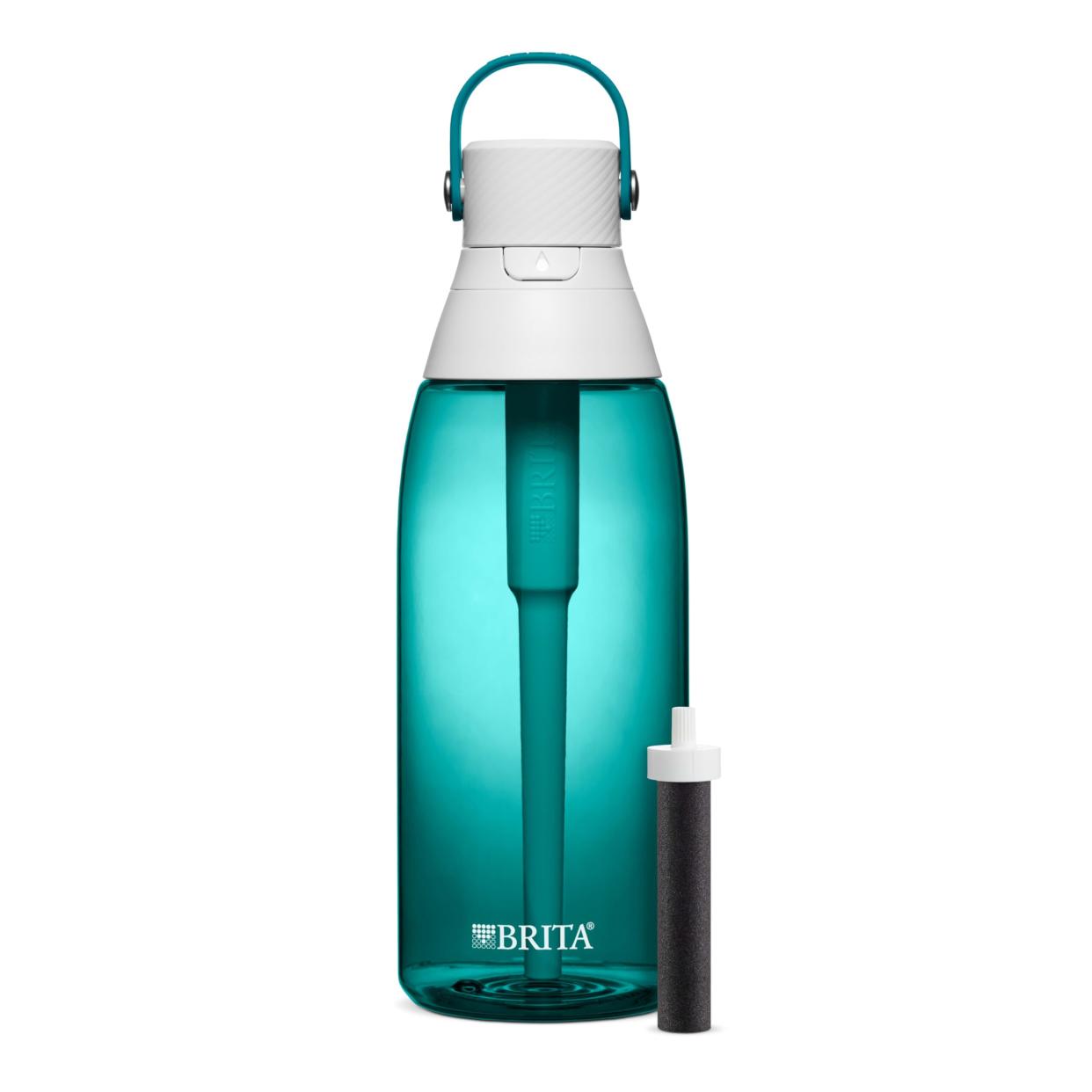
Filtered Water Bottle with Straw
amazon.com
$29.16
Peak Series Squeeze Filtered Water Bottle
The filter of this bottle can be used with other water bottles, hydration systems, or even on its own. It has a covered mouthpiece to keep out dirt, and the bottle itself easily shakes off debris. There’s also an attachment loop on the cap, making it easy to carry or hook to your backpack.
This bottle was one of the easiest to drink from—it doesn’t require much suction to get water through the filter and straw. The exceptional flow rate was also apparent when I used it to filter water and squeeze it into another bottle. This comes in handy for refilling other drinkware or cooking containers.
Cleaning the filter requires backwashing, and a syringe is included. It’s an extra step but a simple one when you’re ready to store it away. The Peak Series is easy to use and pack, but I did notice after about 30 minutes of leaving water in the bottle it took on a plasticky taste the filter wouldn’t get rid of. To be fair, that happens with the first several uses on almost every water bladder we’ve tried.
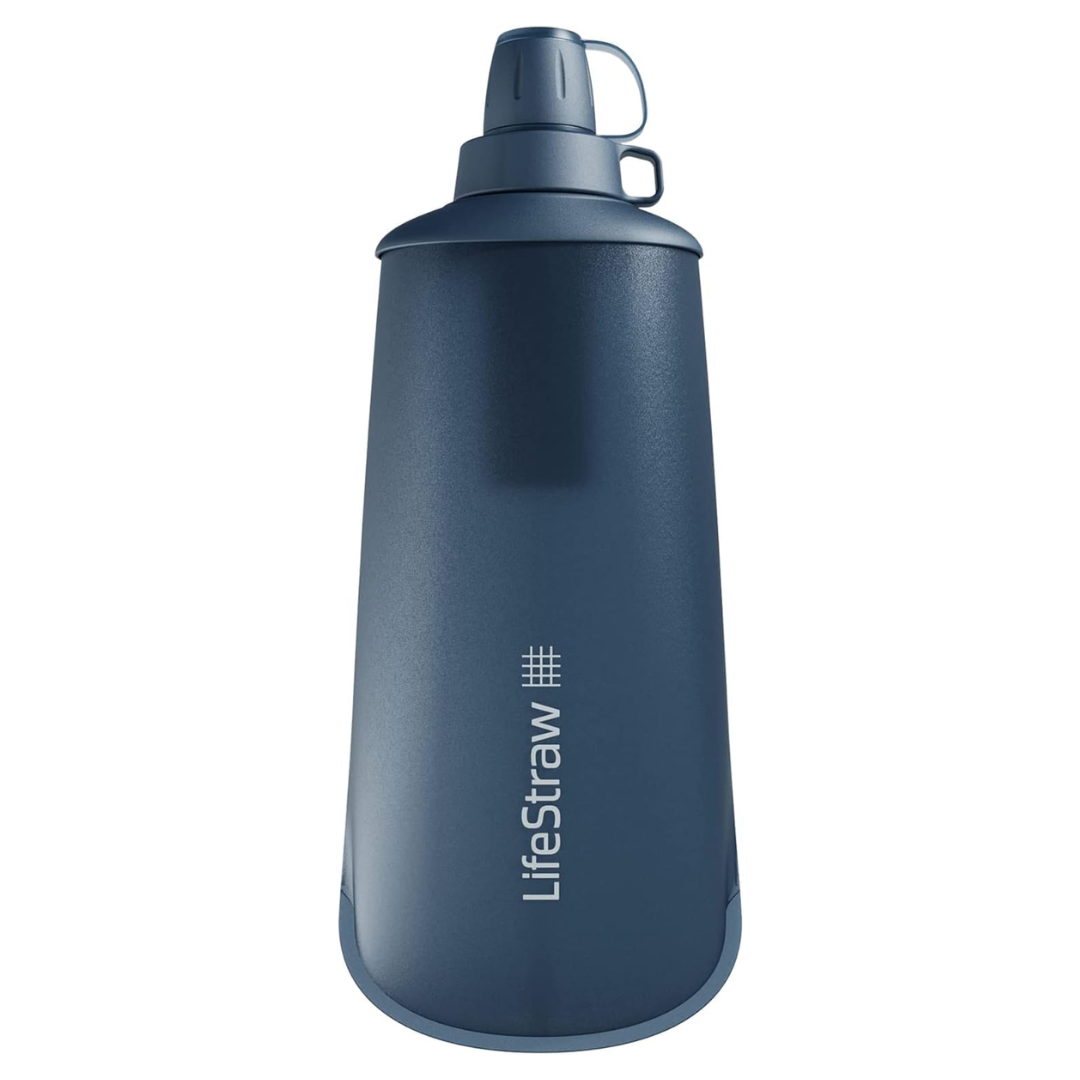
Peak Series Squeeze Filtered Water Bottle
amazon.com
$43.00
Insulated Filtered Water Bottle
The Larq bottle is the sleekest option I tried and the easiest straw to drink from. The filter itself is also quite small, which means less water displacement and more water in my bottle. The leak-proof cap has an attached carabiner, making it easy to hook onto my backpack or waistpack.
I reached out to the brand for specifics on its Nano Zero filter technology, as I couldn’t find it anywhere on the site. I was told it’s an activated carbon filter coupled with an iron membrane microfilter to remove lead, PFOS and PFOA chemicals, and pharmaceuticals—that means the filter improves both taste and quality of the water.
Larq publishes its testing results on its website so you can check to see if it removes the specific contaminants you want to avoid. While other brands publish a summary of results, Larq publishes both a summary and the actual testing results from the third-party labs it uses.
This is the bottle I use most because of the compact design, above-average filtering, and ease of use. The opening is smaller than that of others, so it’s difficult to fill with ice, but that may not be a deal-breaker for everyone.
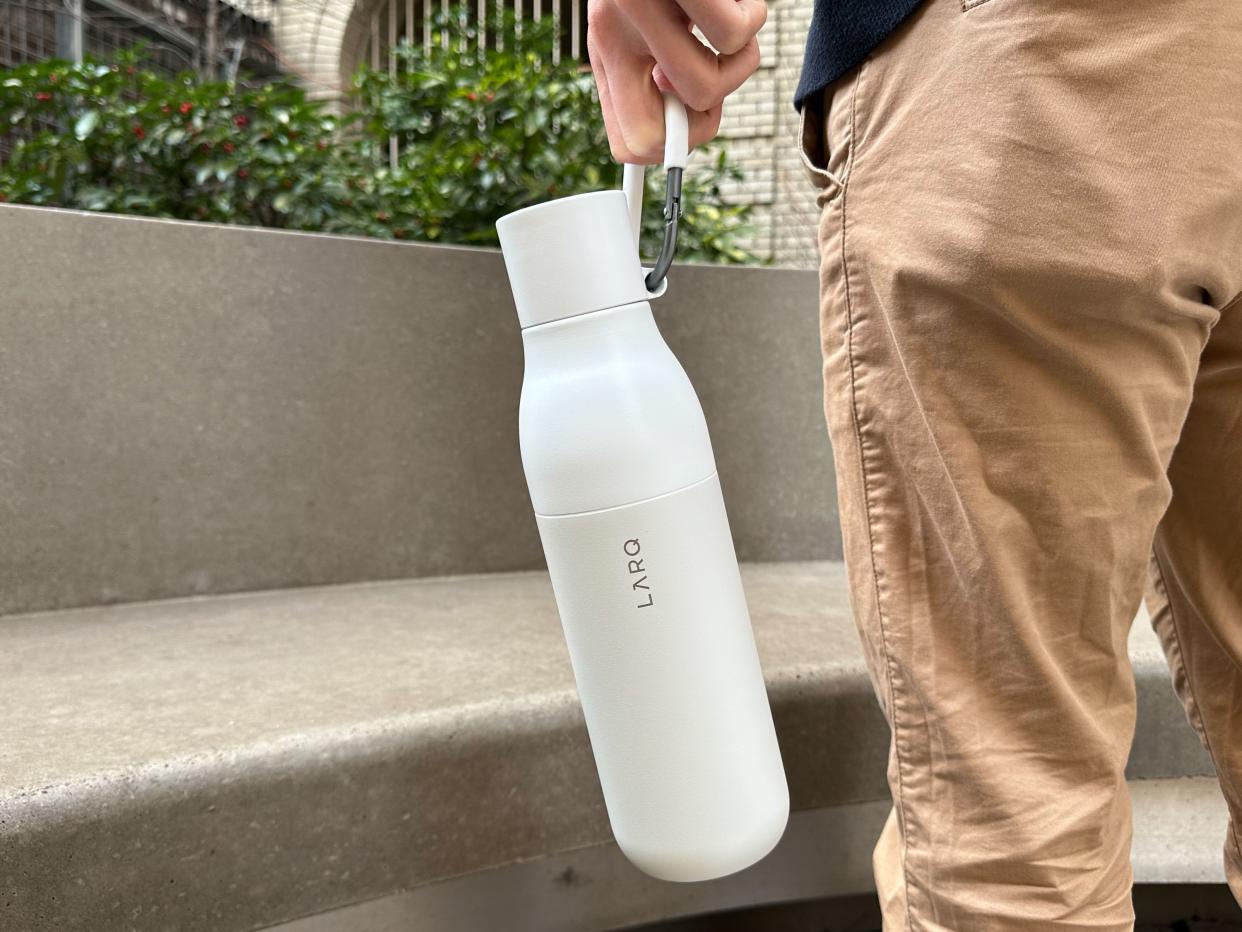
Insulated Filtered Water Bottle
amazon.com
$68.00
Danny PerezBeFree Filtered Water Bottle
Deputy Editor Zoë Hannah uses the BeFree to filter water when thru-hiking because “it packs down to only a few square inches when it isn’t full, and it’s super lightweight.” She’s used it to filter water from non-potable sources as well as to add an extra filtration step if she’s getting fresh water from streams in high mountain areas.
The BeFree uses a 0.1-micron membrane filter that removes bacteria and doesn’t require a lot of suction to drink from. The fast filtering and good flow rate makes it ideal for filling other drinkware or to use for cooking.
“I don’t use it for drinking straight out of very often, mostly using it to push clean water into my water bottle or my bladder for drinking while I hike,” Hannah says. “But when you do use it as a water bottle it’s easy to suck out the water or squeeze it into your mouth.”
She also found it greatly improved the taste whenever she filtered water from suspect campsite taps.
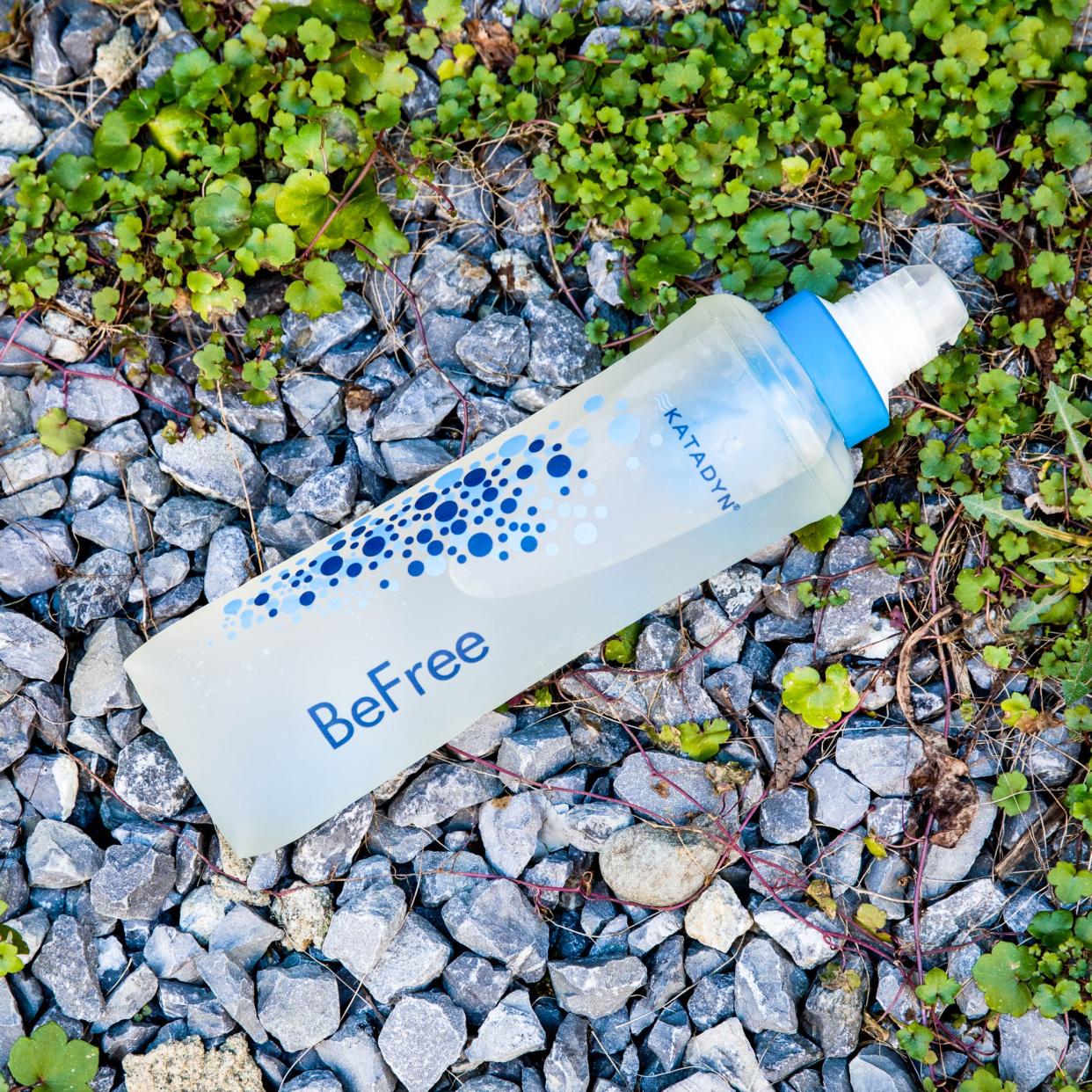
BeFree Filtered Water Bottle
amazon.com
$38.20
Thomas Henggeeddy+ Filtered Water Bottle by LifeStraw
The Eddy+ uses LifeStraw’s two-stage filtration system. Its hollow fiber membrane removes bacteria and microplastics, while the ion exchange filter removes chlorine, lead, and organic matter. The bottle is made of durable, recycled plastic and is relatively lightweight compared to insulated filtered water bottles. The lid has a handle for easy toting or clipping onto gear with a carabiner.
The flip-out straw is leakproof when closed and has a large opening to sip through. However, a lot of suction is needed to get water through the filter and up through straw. I got used to it after a day or so but the Eddy+ is the hardest one to drink from that I tried.
I prefer plastic bottles like these because they’re durable and aren’t heavy and clanky like insulated water bottles. This feels closest to my Yeti Yonder bottle—my all-time favorite—because of it’s in-hand feel and grab-and-go handle. While the filter is bulky, it’s still a lightweight option that can handle its fair share of drops and dings. The filter is also easy to replace and clean.
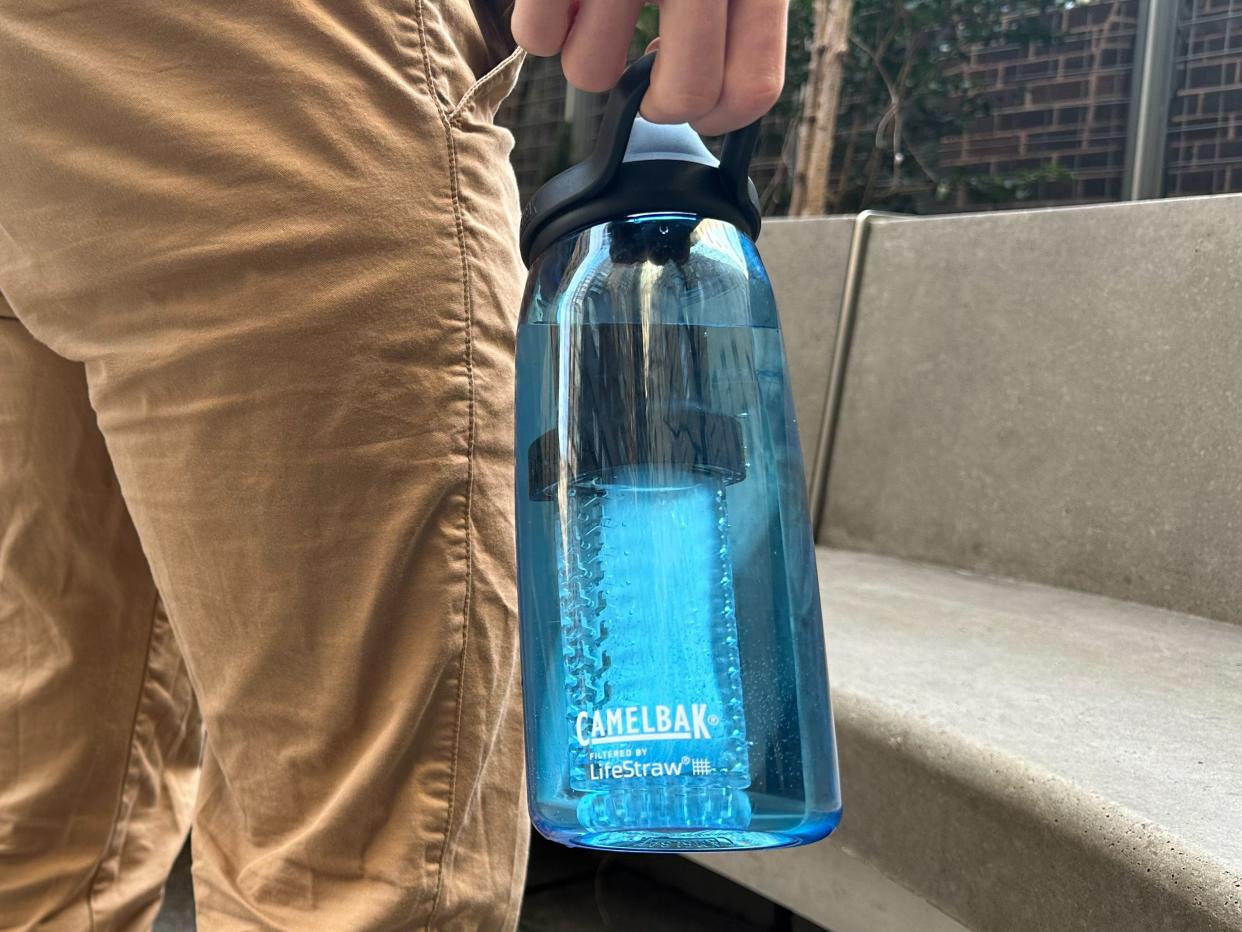
eddy+ Filtered Water Bottle by LifeStraw
amazon.com
$34.99
Danny PerezYou Might Also Like
